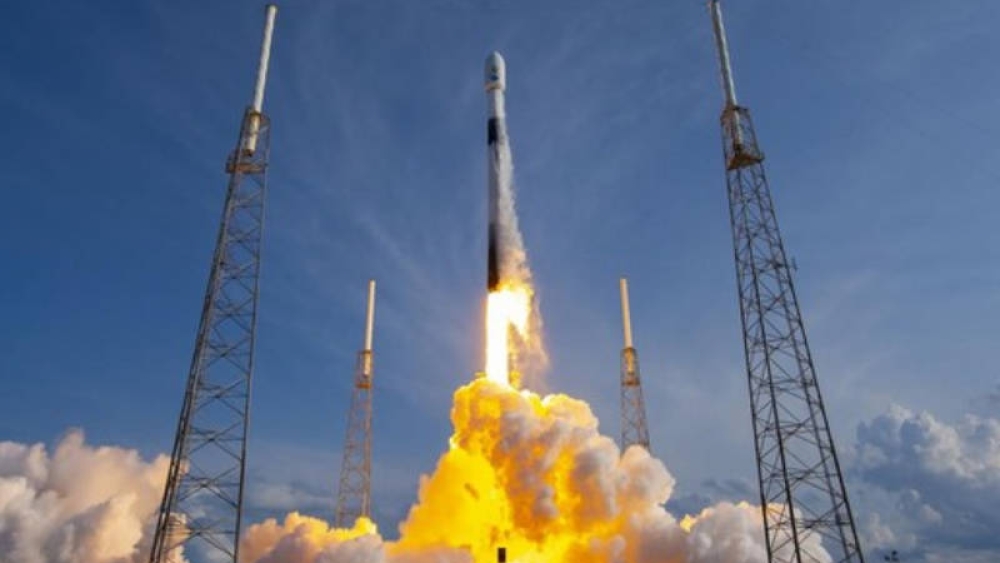Jakarta, June 22, 2023 – PT Pasifik Satelit Nusantara, the first private satellite company in Indonesia, successfully launched the Nusantara Tiga Satellite or also known as the Republic of Indonesia Satellite (SATRIA) into orbit using SpaceX’s Falcon 9 rocket from Cape Canaveral, Florida, United States, on Sunday (18/6) local time or Monday (19/6) Indonesian time. The satellite with a total transmission capacity of 150 Gbps, which is the largest in Asia and the fifth in the world, will create equal internet access in Indonesia.
The launch of the SATRIA Satellite was witnessed directly by stakeholders participating in this National Strategic Project, which is stated in Presidential Regulation Number 56 of 2018 concerning the Acceleration of the Implementation of National Strategic Projects. This satellite will occupy the orbital slot of 146 degrees East Longitude (BT) and is intended for public services in disadvantaged, frontier, and outermost (3T) areas.
PSN Group President Commissioner, Sofyan Djalil, stated that the successful launch of the SATRIA Satellite was a brilliant achievement for the Indonesian Government. The presence of this multifunctional satellite will strengthen the technology, information, and communication infrastructure, thus playing an important role in eliminating the gap in internet access in Indonesia, which is an archipelagic country. By creating equal connectivity, it will accelerate the realization of digital transformation in Indonesia.
“We congratulate and wish success for the successful launch of the SATRIA Satellite. Thanks to the hard work and collaboration between PSN and the Indonesian Government, the Ministry of Communication and Information, Thales Alenia Space, and SpaceX, the SATRIA Satellite was successfully launched into geostationary orbit and is expected to become one of the backbones of infrastructure in bridging the digital divide in the archipelago,” said Sofyan in his official statement.
President Director of PT Pasifik Satelit Nusantara (PSN), Adi Rahman Adiwoso, added that the successful launch of the SATRIA Satellite is only the initial stage in a series of steps towards internet services for remote areas. The next stage is to ensure that the satellite can operate properly so that it supports the government in providing maximum internet services for the people of Indonesia. “PT Pasifik Satelit Nusantara has a very big responsibility and mandate for the community and the country. We need to be accountable for this responsibility and mandate with hard work to provide the best so that it is truly beneficial for the community and the country,” said Adi.
The SATRIA satellite is the first satellite in Indonesia to use Very High Throughput Satellite (VHTS) technology and Ka-band frequency. Thanks to the implementation of VHTS and Ka-Band frequency which is also strengthened by 116 Spot Beams, this 4.6-ton satellite is expected to be able to provide faster internet connection services and wider coverage for 15 years.
Director of PSN Network Operations and Deputy Project Director of PT Satelit Nusantara Tiga, Heru Dwikartono, explained that after the launch, the SATRIA Satellite needed 145 – 151 days of orbit raising process to arrive and occupy the 146 degrees East orbit slot, right above Papua, Indonesia. Heru ensured that PSN would continue to monitor the satellite through the Primary Satellite Control Station and the Network Operation Center in Cikarang, West Java, together with the French space manufacturing company, Thales Alenia Space (TAS), in Cannes. A few days after the launch, the SATRIA Satellite underwent a Platform in Orbit Test, the result of which was a satellite in nominal condition. When it reaches orbit, PSN will conduct a Payload In-Orbit Test to ensure that all satellite devices function normally after launch and the orbit raising process. This stage is estimated to take three weeks.
Next, an End to End System Test will be carried out, which is the final test that the SATRIA Satellite and other supporting ground segment infrastructure, such as 11 earth stations and communication networks have been tested and are functioning properly. The SATRIA Satellite will then be used by the Telecommunication and Information Accessibility Agency of the Ministry of Communication and Information (BAKTI Kominfo) to provide internet services throughout Indonesia.
“PSN as a whole provides satellites along with supporting infrastructure and communication systems which are estimated to be completed in a ready for service condition in December and are ready to provide satellite network services to BAKTI Kominfo. We are also obliged to operate the SATRIA Satellite for 15 years which will be carried out by PSN’s subsidiary, PT Satelit Nusantara Tiga,” said Heru.
The SATRIA Satellite began to be produced by TAS from September 2020 to May 2023. This 6.5-meter-high satellite applies electric propulsion technology that utilizes electric thrusters for movement so that it can extend the satellite’s service life. In addition to collaborating with TAS and SpaceX, PSN also collaborates with The North West China Research Institute of Electronic Equipment (NWIEE), Kratos Defense, and Hughes Network Systems (HNS) in this prestigious project. In this collaboration, NWIEE built the antennas used at 11 ground stations. Meanwhile, Kratos
Defense prepared the SATRIA Satellite Carriers Spectrum Monitoring (CSM) device and Monitoring & Control (M&C) to monitor and control radio frequency devices at 11 ground stations. Meanwhile, Hughes Network provides an IP Processing Hub for the SATRIA Satellite.
“We believe that the SATRIA Satellite is the right solution to accelerate the provision of internet services throughout the archipelago. With the presence of the SATRIA Satellite, we hope that all Indonesian people will have the same opportunities and rights in accessing internet services,” concluded Heru.



